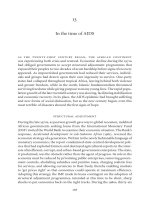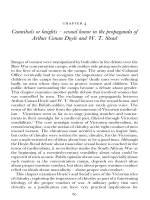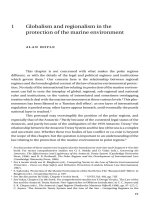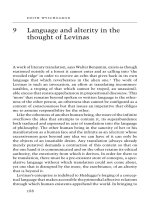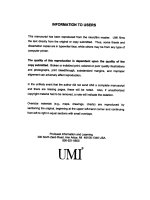Financial Risk Evaluation Methods In The Economics Of Education
Bạn đang xem bản rút gọn của tài liệu. Xem và tải ngay bản đầy đủ của tài liệu tại đây (851.56 KB, 32 trang )
PhD Thesis Summary
Financial Risk Evaluation Methods in the Economics of Education
Máté VONA
Supervisor: Prof. László LOSONCZI
University of Debrecen
Doctoral School of Economics
PhD program “Competitiveness, Globalization and Regionalism”
Debrecen, 2016
1
Acknowledgements .........................................................3
1. Motivation ...................................................................4
2. Structure of the Thesis and Applied Methodology .5
3. Key Research Questions ............................................9
4. Results .......................................................................13
5. Possibilities for Further Research ..........................24
References .....................................................................26
2
Acknowledgements
First and foremost, I would like to thank my supervisor Prof. László
Losonczi and my previous supervisor Prof. István Polónyi for the
great help and support I received. They pushed me forward on the
challenging task of writing a dissertation. They gave me good ideas
and directed my attention to important scholarly questions. They
gave me the scientific freedom that has been ideal for my work. It is
also important to mention Dr. András Kun and Dr. András Semjén
for the important pieces of advice for finishing my thesis after the
institutional review.
I am grateful for the comments, questions and criticism received
from the members and heads of the Doctoral School of Economics,
my colleagues at the Institution of Economics and the Faculty of
Economics and Business Administration. Dr. József Gáll, Dr. Judit
Kapás, George Seel, Judit Futó and Andrea Szabó gave me
exceptional support during the preparation of the thesis. I am grateful
to all the participants in the sections at the internal and external
conferences I have attended and especially those anonymous referees
who gave invaluable advice on the papers I published.
I would like to express my gratitude to the Hungarian Students Loan
Centre, especially Zsófia Slosár and Sándor Fazekas, who helped me
obtain the data which I analysed at length in this research.
I would like to express my thanks for my scholarship that partly
financed my research because this research was supported by the
European Union and the State of Hungary, co-financed by the
3
European Social Fund in the framework of TÁMOP-1.2.1.A/ 2-11/12012-0001 „National Excellence Program‟.
Last but not least, I must mention my loving and caring wife Anett,
and family and friends who supported me throughout this long
research process. Without them this study might never have become
a reality.
.
1. Motivation
The economics of education traces its roots back to the first
economic thinkers like Adam Smith. However the ideas that
influence contemporary research date back to the 1960‟s and the 70‟s
(Varga 1998). The emergence of this topic in that particular era in
economics is not a coincidence. That was the time when the effects
of high level general education started to take effect and masses of
people gained access to higher education in the western world. It will
be discussed in the dissertation how large is the group of those who
are affected by the education system. Basically it cuts through the
whole of society. If we assume that education is mainly an
investment and its payoff is future income advantage, than it is
natural to ask what the risks of that investment are. When I studied
this field I was surprised that it is not as rich with studies as other
topics, such as the rate of return to education or the economics of
tuition fees. This led me to the topic of the dissertation which is risk
evaluation methods in the economics of education.
4
2. Structure of the Thesis and Applied Methodology
The main question of the thesis is the following: what is the role of
risk in individual higher educational choice and what are its shortterm macroeconomic implications? Namely, whether it can cause a
macroeconomic crisis if individuals experience negative rate of
return to education on a mass level? For the better understanding of
this question, I devote Chapter 1 of the dissertation to the
interpretation
of
risk,
individual
educational
choice
and
macroeconomic implication. These are concepts that can have many
interpretations. I will approach the topic of risk and education using
the tools of economics. In Chapter 1.1 the main concepts and
definitions of risk and its measurement will be described, risk being
one of the main topics of financial economics. In this dissertation
investment risk will be discussed. It is related to uncertainty of future
returns, however, in case of risk, some knowledge on possible
outcomes is assumed. The main economic example of risky
investment is investment in financial assets. In Chapter 1.1 a short
introduction to the Markowitz model will be given based on Merton
(1972). The main idea of the Markowitz portfolio theory is that there
are efficient baskets of financial investments, in other words
portfolios that are favourable. It is assumed that decision-makers
prefer more return over less return at given level of risk and less risk
over more risk at given level of return. Risk is basically an economic
bad in that sense.
5
After the introduction to the economic theory of risk, it will be
applied for higher education in Chapter 1.2. In economics the social
role of education is explained by numerous theories. Consumption
theory suggests that education is similar to other consumption goods.
Human capital theory proposes that people choose to invest in
education to increase their future productivity and to earn a higher
level of income. Sorting theories argue that education is a solution
for labour market information asymmetry. People study to signal
their productivity and the education system is a screening device.
(Varga 1998) Human capital and sorting theories have received the
most attention so risk will be discussed in these two cases. The
discussion will be narrowed down to higher education because that is
the market where the financial stakes are the highest for individuals
and individual decision-making is easier to accept as an assumption.
Result 1 of the thesis will concern the role of these theories in
evaluating the risk in educational choice. It will be concluded that in
the main characteristics there is no difference in the role of risk in
educational choice depending on the theory we use for education,
however, there are some differences that can be useful, so they
should be kept in mind.
Chapter 1.3 focuses on social implications. Individuals win or lose
compared to the expected return. At a macroeconomic level risk
appears as the interaction of the markets. Macroeconomic theory
suggests that there is a long run level of national output and it is
expected to grow in time if certain conditions are met. If the output
of the economy decreases and it is under the long run level, we talk
6
about an economic crisis. If market risks add up 1 and
underperformance is experienced, especially on a market that has a
strong relation with the income of individuals; it can spread through
the entire economy. This will decrease the aggregate demand, which
as a result will lead to an economic crisis. In Chapter 1.3 the
fundamental ways for funding higher education and the ideas behind
an economic crisis caused by a setback at the higher education
market will be discussed.
After the theoretical review in Chapter 1, in Chapter 2 an overview
of the empirical literature of the topic is provided. First of all, the
kind of heterogeneity measured is discussed, together with its
measured determinants in the literature. Secondly, it is discussed in
great detail who have used the Markowitz theory for education
programmes2 and what results they have had. Result 2 of the thesis
will be derived from some empirics from Education at a Glance
2014. That set of data indicates that student loan markets are
evolving fairly slowly. Thirdly, it is shown who suspects that
education can create an economic crisis and what kind of empirical
observations they found for their argument. All these topics will be
dealt with in their respective subchapters.
1
By the term risks adding up I mean a situation where the worst case
scenarios play out for many of the market participants at the same
time.
2
I refer to formal education when it has a certain duration and field
of science; an education programme, for instance, a BSc in
Engineering or an MSc in Health Science
7
In Chapter 3 data and methodology is introduced for the empirical
results of the thesis. My thesis contributes to the literature on
Markowitz theory in the economics of education. A sample of the
Hungarian student loan borrowers is examined. This sample is
especially interesting because student loan borrowers might be
taking the highest risk compared to other ways of funding.
For the social implication study international data sources were used,
including the World Bank and the Education at a Glance report of
OECD.
Chapter 4 includes the analysis and the empirical results of my
thesis. The first analysis concerns the role of risk in educational
choices. In Chapter 4.1, I compare the measured risks and the returns
with scatter-plots for my sample of 34 educational programmes of
the Hungarian higher education system. Education programmes in
this thesis are defined by a certain level of education and a certain
field of education. For instance, they include a Bachelor‟s in
Engineering or a Master‟s in Social Sciences. Result 3 of the thesis
will suggest that the empirical findings are similar to the findings of
Palacious-Huerta (2003), Christiansen et al. (2007) and Glocker –
Storck (2014). Some educational programmes seem to fit the
efficient frontier while other can be found within the feasible set. A
possible explanation for it is that sample members are not following
the
Markowitz-type
of
ordering.
Sharpe-ratios
offer
some
explanations to this phenomenon. These results are new because
these relations were only shown for the most developed countries
including the United States, Germany and Denmark and not
8
especially for student loan borrowers. The Sharpe ratio findings are
also new to the literature. These findings are summarized in Result 4.
Chapter 4.2 will consider short-term social implications of risk
accumulation on the education market. First, I narrow down my
analysis to such countries where the average individual financial
commitment to studies is the highest. The United States will remain
as the prime candidate for an education market induced crisis. With
the help of graphs and tables, I compare the relative size of the
education market of these countries to other markets that are very
closely related to macroeconomic performance. Result 5 of my thesis
will state that the education market and the student loan market in
the USA are still too small for such a social impact to appear.
However, these markets are too small, a future exponential growth
might increase them. Result 6 of my thesis argues that even in that
case the fundamental features of education as a human capital
investment limit the possibility for extreme market corrections.
My thesis will end with a conclusion highlighting my main results
and the implications of them and will also outline future research
possibilities.
3. Key Research Questions
Risks of education investment were pointed out as the motivation for
the dissertation. First of all, the economics approach was chosen
from among the branches of sciences that conduct education
research.
9
Both theoretical and empirical studies have been made on the risks
of human capital investment. As an example of the complex issue in
question, there is an ongoing argument in the literature as to whether
education increases or decreases labour market risk. Should it be
approached as a risky investment or an insurance against a larger
risk? (Anderberg – Andersson 2003, Jacobs et al 2009, da Costa –
Maestri 2007). In the risk evaluation of education investment this
question should be addressed.
This literature has led to two branches of human capital theory where
risk has an essential role. One is financial, related to the tools of
higher education financing. The other is more microeconomic and
studies the role of risk in choosing among education levels,
education programmes, and the role of individual features in this
choice. These are the two topics the dissertation contributes to and
the questions of the dissertation are derived from those fields.
Main question
What is the role of risk in individual higher educational choice and
what are its short-term macroeconomic implications? Namely,
whether it can cause a macroeconomic crisis if individuals
experience negative rate of return to education on a mass level.
Sub-question 1
Do students follow Markowitz ordering behaviour in choosing the
field of education they take part in if we apply the standard
Markowitz theory of risky investments, where the risk is measured by
10
the standard deviation of the rate of return to education investment;
then do the risk-return combinations for different fields of education
fit a so-called efficient frontier which is the section of a hyperbola
with a positive slope in the risk-return space?
Sub-question 2
Are there any patterns in the evolution of student loan markets or the
products available on student loan markets? Are there any markets
where private commitment to student loan systems is extreme?
Sub-question 3
Can student loan markets experience exponential growth? Can the
decreasing enthusiasm at the end of such growth cause the kind of
financial turbulence typical of such markets as the equity market,
mortgage loan market or foreign exchange market?
Based on the literature of these questions and the databases available
for the research, the following hypotheses were tested.
Hypothesis 1
Student loan borrowers in Hungary who paid back their loans
between 2008 and 2012 do not follow the Markowitz ordering
investment behaviour towards education programmes of different
levels and they tend to choose programmes that do not belong to an
efficient frontier in a risk-return space, defined by measures that are
11
tested in the branch of literature characterised by Palacious-Huerta
(2003), Christiansen et al (2007) and Glocker – Storck (2014).
Hypothesis 1 will be answered in Chapter 4.1 and Result 3 and 4 will
summarize it.
Hypothesis 2
High levels of education investment can be achieved without costsharing and a high level of private investment in education. Student
loan schemes are introduced slowly and they appear in many
models. There are outstanding countries in private investment and in
the use of student lending.
The answer for Hypothesis 2 will be the result of the evaluation of
the basic empirics and empirical literature of the field. It will be
summarized in Result 2 in Chapter 2.
Hypothesis 3
Growth on the higher education market is an exponential growth
process. Human capital investors overvalue the growth opportunities
in their future income, so they pile up current debt at a level that
they cannot finance from the earnings on their investment. When
they realise the true return on their human capital investment (their
true earnings after graduation) they will find that they cannot pay
back their student loan debt. This will happen on a mass level. The
student loan default rate will be so high that it will affect the
financial markets. This can cause financial crises at least on a
national level, but a future global crisis is also possible.
12
Hypothesis 3 will be examined with macro level comparison in
Chapter 4.2 and Result 5 and 6 will conclude the outcome.
4. Results
Result 1 was based on the review of the theoretical literature.
Result 1
The literature review of economics of education has showed that two
investment-type sets of theories are offered. Risk has different
sources in human capital and sorting models but they have not been
fully compared yet. The main result of my literature review is that in
both theories risks can be summarized in the fluctuating nature of
future income. However, in the case of human capital theory
education produces some additional productivity irrespective of the
credentials. This suggests that even an unfinished education
program can have long-term effects. In case of signalling a dropout
from education usually means large decrease in the return to
education and even successful completion can have a minimal value
if too many people have equivalent education signals. This can be
attributed to the fact that the cost structure of education does not
result in a separating equilibrium. That is important because it has
to be taken into consideration in Result 6.
I have started to analyse my hypotheses by reviewing empirical
literature. The review gave me the answer to Hypothesis 2. It was
Result 2 of the thesis and it is derived in Chapter 2.
13
In Chapter 2 it was shown that elementary and secondary education
are mostly obligatory and a major proportion of the age group takes
part in education on those levels. From the point of view of risk in
education, higher education is much more interesting. It is voluntary,
expensive, and takes a lot of time to finish and adults are making
decisions on entering or leaving the education system. Education as
human capital accumulation has not only private but public benefits
as well. It was shown that there are four participants who have an
interest in individuals getting more education. First of all, the
individuals themselves, the students. Then there are the households,
the family and relatives who support the students. Future employer
companies and other private entities can have an interest in a better
educated future labour supply. Last, but not least there is the state,
which should represent the interests of society in the potential
externalities of education and help in overcoming the inefficiencies
of the education market, such as information asymmetries and a lack
of financing for students. The state should promote equal
opportunities and fairness. Public higher education funding works in
two ways; either it is higher education institutions that are supported
or private entities such as students, households and companies. In
many cases the state finances higher education institutions, many of
them are state property, and then the institutions offer tuition-free
education. Individuals in a human capital model base their decisions
on the costs and return of an additional year or level of education.
(Johnstone 2004)
14
Tuition fees or other financial costs, including living expenses, are
not the only costs. Education is time consuming so the investor must
take into consideration foregone earnings as the opportunity cost of
education. To the best of our knowledge, the majority of expenses
are foregone earnings. Educational choice is risky even if it requires
marginal direct costs to enter a programme because the future
earnings advantage in many cases does not justify the effort that was
made or the earnings that had been given up. In some countries even
the direct costs are fairly high because the state actively shares the
costs of education with the private sector. If an education system is
built on high tuition fees, there is a system to support the investors.
Frequently used types of student aid include grants, scholarships and
loans. Student loans are special in the sense that they do not decrease
the risk of taking part in an education program, but only help to
spread the cost between different time periods. Student lending is
also special because it is different from other investment loans as the
object of the investment cannot be mortgaged and the usual student
borrower has no other possessions to be mortgaged. The second
result was the result of the analysis of Hypothesis 2.
Result 2
Student loans are elements of cost-sharing and they tend to increase
spending on education. They are the tools of financial support for
students. Building up a large student loan market takes decades and
the features of a market are difficult to predict. Some countries,
however, stand out; here private investment is relatively high, and
15
student lending has an important role and tradition. This result is
against the idea of a rapid spontaneous growth of a student loan
market.
Result 2 is an important argument against the idea of a student loan
crisis and gives fundamentals to narrow down the macroeconomic
analysis to some special countries.
Another line of literature focuses directly on the returns of education
and questions the apparent heterogeneity in return. The higher
education system offers very different opportunities based on gender,
ethnicity, college choice, family background and social status. The
topic of rates of return to education is very well-researched but
foreseeable and unforeseeable heterogeneity has a rich literature as
well. As the education system is more open than ever, many people
enter it in the hope of a great career. The issue of risk and wage
differences deserve as much attention as expected returns. There is a
line of literature that directly relates to the risk approach used in the
theoretical review. They use Markowitz type of analysis to evaluate
educational decisions. The literature suggests that not all educational
decisions can be fitted into an efficient frontier predicted by the
model. This suggests that some investors take too much risk. Is this
true for student loan borrowers?
If these risks add up, it can lead to a crisis. Can it spread to a
macroeconomic level? Some - mainly in the United States - suspect
that the expending tuition fee and student loan market might be a
16
factor in the next economic crisis. If we are studying risk in
education investment this topic must be addressed.
After the analysis of empirical literature, I have remained with two
unanswered hypothesis, they were Hypothesis 1 and Hypothesis 3.
An empirical analysis of a Hungarian Student Loan borrower sample
was performed and a comparative analysis of the big student loan
markets was introduced in Chapter 4.
Result 3 and 4 are derived in Chapter 4. In the micro analysis the line
of literature of Palacious-Huerta (2003), Christiansen et. al. (2007)
and Glocker – Storck (2014) is followed and the focus was on the
field of education. An analysis of a data sample from the Student
Loan Centre of Hungary was carried out. This is not a public
database but no data was provided to me or any of my colleagues
that has any reference to borrowers‟ identities. Neither do my results
have any relation to the business policy or profitability of the Student
Loan Centre.
The data sample is for a yearly annual gross real income from 2008
to 2012. The Hungarian student loan scheme is income contingent.
They receive income data in order to calculate the necessary
payment. The payment can be 6% or 8% of the income two years
prior to the due date of the payment. The first two years payment is
based on the minimum-wage.
Individuals entered the sample if they had recorded income for any
of the years in the indicated time period. The focus of the
examination is on education programs. Those programs were
selected where at least 30 individuals' incomes were recorded for the
17
whole time period. Only state financed and full time education
programs were evaluated. Those who participated in more than one
type of education program were excluded, as well as those who had
no reported income. The equal costs assumption does not apply to
those who participated in several different ISCED-coded programs.
The final sample contained data for 20,146 individuals in 46,229
observations for 34 education programs.
One of the main results was that if raw logarithmic income and timeseries standard deviation was calculated (Figure 1), a set of
experiences fits the theory of risky investment by Markowitz in the
sense that they lie on the frontier of the feasible set of investment
possibilities.
Figure 1: Scatter-plot of Raw Logarithmic Income and its
standard deviation
Source: Based on Student Loan Centre Data
18
Even the equation of the efficient frontier could be fitted, which is
completely new to the literature. It fits the results with an R2 of 0.79.
Some programmes lie along a part of the frontier which is not
optimal according to the theory because higher return-less risk
combinations can be found. They are optimal only according to one
criterion, by offering the minimum of risk for the given level of
return. There can be several explanations for this. There can be some
kind of human capital or financial barrier that does not allow
individuals to choose longer education programs with favourable
risk-return combinations.
Figure 2: Scatter-plot of Mincer Residuals and their cross
sectional standard deviations
Source: Based on Student Loan Centre Data
For instance, an MSc in Health is one of the best combinations in a
risk-return sense. The theory would claim that people must prefer
19
MSc in Health over a BSc in Health or VT in Health Sciences. It is
interesting that we have found this in a student loan borrower sample
because they had access to financial aid and they received it, so
financial barriers are not necessarily the answer to heterogeneity.
Result 3 of thesis was phrased based on these findings.
Result 3
With risk and return measured by the simple measures of average
raw logarithmic income and the time-series standard deviation on a
data sample of Hungarians who paid back their student loan
between 2008 and 2012, a great fit for the frontier offered by the
Markowitz-theory of risky investment can be found. Some of the riskreturn combinations are not efficient. Due to the fact that the sample
members are student loan borrowers, the role of financial barriers is
not necessarily the explanation for this. There is uncontrolled
heterogeneity in the sample and it can impose investment barriers
that withhold access to higher levels of education investment.
However, the time-series standard deviation of the average raw
logarithmic income should be approached carefully because the
results of the measure can be misleading. A strictly growing income
series will produce a large standard deviation with this measure.
Cross-sectional standard deviation is a better measure for risk.
The literature for rate of return calculations offers control variables
such as gender, college choice and family background. In the dataset
gender was known, college choice is controlled by the location of the
college and social background is controlled by the place of
20
permanent residence. Mincer-residuals and their cross-sectional
standard deviation were used for the sample (Figure 2). The result
was a similar risk-return map that was observed in the literature and
even similar type of education programmes were found to be more
fitting to the model. Sharpe-ratios were also examined and it led to
the conclusion in Result 4.
Result 4
The observation for return and risk of fields of education by
Christiansen et al (2007) and Glocker – Storck (2014) was validated
on a special sample of data. For the Hungarian student loan
borrower sample it was seen that some fields of education seem to fit
the so-called efficient frontier and some lie well within the feasible
set of risk-return combinations. There is even an observable pattern
that social sciences and law, high level health studies, and high level
engineering studies seem to fit the frontier and short term education
programs, humanities and art studies tend not to fit. The risk-return
behaviour of human capital investors seems to be the same as in very
developed countries. Sharpe-ratios offered some explanations for
heterogeneity. Sharpe-ratios tend to decrease with the length of
education; however, within a field there are mixed results. There is
unobserved heterogeneity and there is a need for more sophisticated
control variables.
These results indicate that even for student loan borrowers education
can be a risky decision and in many cases the expected return is
lower then what would be optimal. This made the comparative
21
analysis necessary. However, as Result 2 stated that student loan
markets were slowly developing markets, exponential growth can
change that. I compared the features of the student loan markets and
human capital investment to other, more threatening in the sense of
financial crises, forms of investments. This gave me Results 5 and 6.
Chapter 4 analyses the possibility of a macro crisis triggered by a
student loan exponential growth. It is pointed out that candidate
countries for such a phenomenon mainly include the United States.
The case of the United States is discussed in some detail. Result 5
was phrased in terms of a comparison of higher education spending
to other markets, student loan debt to other sources of debt, the debt
burden student loan creates and the status of those who have student
loan debt over those who do not. Hypothesis 3 can be rejected by
Result 5 and Result 6.
Result 5
The United States has the largest student loan market. Even after
decades of growth that student loan market is smaller than the usual
crisis-causing markets such as the equity market, household debt, or
government debt. If we compare the compiled student loan with the
total household debt we see that the share of student loans in the
total level of debt has risen from 1% to 9% during the last decade,
but it is still small compared to mortgage loans. In the 2012-2013
educational year 110 billion dollars were lent, but only 8% of this
was non-federal. The state is heavily involved in financing higher
education and there are existing channels where a bailout can be
22
easily performed. College graduates can expect an income that is
enough to pay back their debt. There is only a possibility of a niche
market crisis, such as a for-profit education crisis.
There are references to parts of Result 5 in the literature; in fact, it
was phrased using them. As far as the author is aware, this kind of
counter-crisis evidence collection has not been performed. But
Result 5 only states that the current market is not a macroeconomic
risk factor and those who expect a crisis predict exponential future
growth. So additionally, Result 6 is offered, arguing that education
investment cannot be a crisis factor because of its nature.
Result 6
The higher education market and the student loan market are not, by
their nature, markets in which large positions can be accumulated,
involving a major portion of the economy, and extreme future
expectations can be created. The reasons can be summarized in the
following 4 points:
1. Human capital investment can only be made by humans.
Institutional investment (hedge funds, banks, pension funds,
investment portfolios) can only support humans, but it is not
tempting for them, compared to actual ownership of other financial
assets.
2. There is a limited possibility to scale up investment in human
capital. One cannot invest millions of dollars in education and
expect millions back. With other investment assets this is possible.
23
3. Human capital investment has internal value. Human capital
investment produces skills and knowledge that can be sold. Even if a
human capital investment has little short run return, in the long run
it is more likely to have a payoff. However if Result 4 is taken into
consideration, it is arguable that education investment always
produces some internal value.
4. Average real wages in society fluctuate very little over time. To
experience 4 or 5-fold growth in tuition fees there has to be equal
growth in real wage expectations. There are hardly any grounds for
this.
Results of the thesis can be combined into a concluding remark to
answer the research question: The main question of the thesis can be
answered in a nutshell by claiming that based on micro-level data it
is very difficult to reject the idea that even some student loan
borrowers take more risk than it is justified by future returns, but the
possibility of a macro-level crisis triggered by student loan defaults
can be rejected.
The essence of the research was published in Vona (2014a), Vona
(2014b), Vona (2015a) and Vona (2015b).
5. Possibilities for Further Research
The dissertation concludes with suggestions for further research.
Usually a PhD dissertation is a report on certain milestones reached
24
during a research programme. Some results might open up new
directions for further research and some can contribute to the work
of other researchers. In this chapter possible spin-off research
opportunities will be listed for the future, which might individually
produce valuable papers if the results match the expectations.
Chapter 4 rejected the potential for a macro crisis to develop from a
student loan crisis; however, based on the simple relationships in that
section, we can easily highlight cases that could offer very exciting
prospects for processing as a case study. A case in point is that of
Chile, which has long been committed to a regime of financing of
higher education that is numerically similar to a possible model that
we could also recommend to countries following the large state
involvement model. For the time being, these ratios are not yet
reflected in a high per capita GDP; research with a case study could
enable us to identify the economic impacts. The cases of Poland and
Estonia lend themselves to case studies. The social embeddedness of
the rapid emergence of Estonia could be an interesting topic.
Chapter 4 also highlighted for-profit higher education in the United
States. It is a niche market within higher education, where
disproportionate distributions can be witnessed; there are large
private investments and a high dropout rate, so a thorough and indepth analysis of that market can contribute to the existing literature.
Furthermore, student loans and their impact on educational choices is
also a relatively poorly charted area in the literature. Fortunately,
more and more secondary data enabling complex statistical analyses
will become available concerning the financing of education. It will
25
